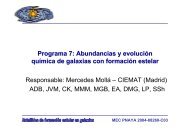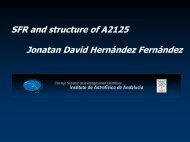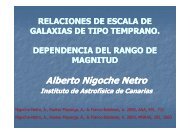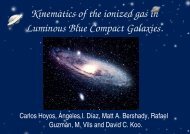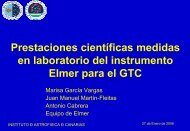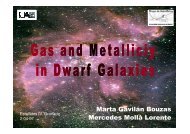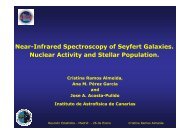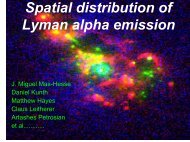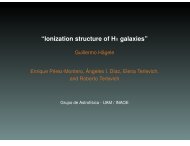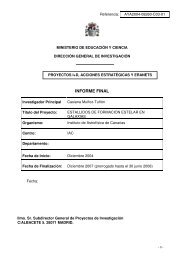in galaxies
Diapositiva 1
Diapositiva 1
Create successful ePaper yourself
Turn your PDF publications into a flip-book with our unique Google optimized e-Paper software.
ESTALLIDOS IV<br />
A multiwavelength approach<br />
to star formation<br />
<strong>in</strong> <strong>galaxies</strong><br />
Webmaster<br />
Enrique Pérez-Montero,<br />
Rubén García-Benito<br />
& Ángeles I. Díaz
Pair of BCD<br />
Distance = 18.2 kpc<br />
IIzw71<br />
IIzw70<br />
B-Band<br />
P. Papaderos, K.G. Noeske, L.M. Cairós,<br />
J.M. Vílchez, K.J. Fricke<br />
HI map: massive HI streamer or<br />
gaseous bridge connect<strong>in</strong>g the dwarf<br />
<strong>galaxies</strong> (Balkowsky et al. 1978)
A.L. COX et al. (2001),<br />
observe HI gas <strong>in</strong> regular<br />
Rotation about the m<strong>in</strong>or<br />
axis of the polar r<strong>in</strong>g <strong>in</strong><br />
IIZw71 and none that<br />
shares the rotation of the<br />
S0 disk.<br />
Polar R<strong>in</strong>g Galaxy<br />
IIzw71<br />
B-Band<br />
IIzw70<br />
Polar r<strong>in</strong>g <strong>galaxies</strong> are made-up of two dist<strong>in</strong>ct<br />
systems : the host galaxy and the polar r<strong>in</strong>g.<br />
The host galaxy is a normal galaxy that<br />
gathers stars <strong>in</strong> a rotat<strong>in</strong>g disk. It is surrounded<br />
by a rotat<strong>in</strong>g r<strong>in</strong>g, that conta<strong>in</strong>s stars and<br />
<strong>in</strong>terstellar gas clouds. This r<strong>in</strong>g is<br />
perpendicular to the plane of the host galaxy<br />
disk.
IIZw71: Presence of<br />
several Hα very<br />
lum<strong>in</strong>ous knots<br />
distributed <strong>in</strong> a polar<br />
r<strong>in</strong>g.<br />
Analysis of these different<br />
bursts<br />
of star formation and derive<br />
its properties<br />
DATA<br />
IIzw71<br />
B-Band<br />
IIzw70<br />
S<strong>in</strong>gle long-slit exposition of<br />
the ma<strong>in</strong> bursts of star<br />
formation <strong>in</strong> the direction of<br />
the r<strong>in</strong>g of IIZw71<br />
Available photometry<br />
<strong>in</strong> several bands
S<strong>in</strong>gle long-slit<br />
Available photometry<br />
<strong>in</strong> several bands<br />
ISIS + WHT dur<strong>in</strong>g 1 night <strong>in</strong> July, 8th<br />
2005.<br />
- R600B grat<strong>in</strong>g - blue arm<br />
-R300R grat<strong>in</strong>g<br />
- Spectral coverage: 3500 Å to 1 micron<br />
-Spectral resolution 0.45 Å / pixel 1<br />
(arcsec width slit)<br />
- UBVR images: Luz<br />
Mar<strong>in</strong>a Cairós (THANK<br />
YOU!)<br />
-Hα image belongs to the<br />
Palomar Atlas of BCDs.
B<br />
V<br />
R<br />
U<br />
B<br />
V<br />
U<br />
Hα<br />
R
Hα image
Flux Hα Spectroscopy<br />
Hα Image
Measure UBVR photometry <strong>in</strong><br />
REGIONS (Hα KNOTS)<br />
A<br />
B<br />
C<br />
D<br />
REGIONS def<strong>in</strong>ed over Hα image<br />
Align Hα and UBVR images
REGIONS<br />
photometry<br />
Spectroscopy<br />
vs<br />
Slit photometry
B<br />
A
D<br />
C
Red : velocity<br />
Velocity (km/s)<br />
A<br />
B<br />
C<br />
D<br />
Fwhm (k/s)<br />
Blue: Hα<br />
<strong>in</strong>tensity<br />
Green:<br />
Cont<strong>in</strong>uum flux<br />
Violet: Hα fwhm<br />
Enrique Pérez Jiménez<br />
K<strong>in</strong>ematical study
c(Hβ)<br />
Redden<strong>in</strong>g<br />
-Quotients of the detected Balmer l<strong>in</strong>es (Hα, Hβ, Hγ and Hδ)<br />
and Hβ <strong>in</strong> relation to the theoretical expected values and the<br />
ext<strong>in</strong>ction curve.<br />
-Slope estimator constant of redden<strong>in</strong>g<br />
-Galactic ext<strong>in</strong>ction is negligible<br />
-Only knots well covered by the slit lead to values of C(Hβ)<br />
clearly larger than 0.
Metallicity<br />
-Cannot measure auroral l<strong>in</strong>es (electron temperatures)<br />
-Use strong emission l<strong>in</strong>es to derive the metallicity by means of empirical calibrators.<br />
-N2 ([NII] 6584 Å), almost redden<strong>in</strong>g unaffected shows gradient of metallicity from A to C <br />
due to different coverages of the regions <strong>in</strong> the slit.<br />
-For R23 ([OII] and [OIII] l<strong>in</strong>es) trend is opposite to that obta<strong>in</strong>ed from N2.<br />
-[SIII] l<strong>in</strong>es (not possible <strong>in</strong> A OH sky l<strong>in</strong>es problems), S23 parameter shows values of the<br />
metallicity accord<strong>in</strong>g with the values found <strong>in</strong> BCDs not large variations between each knot.
PHOTOMETRY<br />
Slit<br />
vs<br />
Region
Jesús Maíz
C H O R I Z O S<br />
UBVR Photometry<br />
Starburst 99<br />
C<br />
Z=1.00<br />
E(B-V)<br />
(Color Excess)<br />
Log(AGE)
CHORIZOS vs SPECTROSCOPY<br />
Color excess<br />
A<br />
D<br />
B<br />
C<br />
Slit worse χ 2 fit
A G E<br />
C<br />
EW(Hβ) = 110 Ǻ<br />
EW(Hβ) = 12 Ǻ<br />
D<br />
Z=1.0<br />
A<br />
B<br />
EW(Hβ) = 50 Ǻ<br />
Z=0.4
C O N C L U S I O N S<br />
Long slit spectroscopy<br />
(upto 1 micron) <br />
diagnostics of the ionised<br />
gas <strong>in</strong> Giant Extragalactic<br />
HII regions.<br />
Incorrect coverage of the<br />
knots <strong>in</strong> the selected<br />
apertures can lead to<br />
underestimate the redden<strong>in</strong>g<br />
and the metallicity.<br />
Objects with complex spatial<br />
distribution Spectroscopy<br />
with spatial resolution (i.e. 3D<br />
spectroscopy):<br />
Colaboration with Carol<strong>in</strong>a<br />
Kehrig (PMAS, INTEGRAL)<br />
Colaboration with Luz<br />
Mar<strong>in</strong>a Cairós & col. <br />
Study of IIzw71 & IIzw70<br />
Young+old stars, gas, dust<br />
hard to characterize star<br />
populations.<br />
Importance of<br />
multiwavelength study:<br />
-Spectra + Photometry<br />
-Stellar populations, SFH,<br />
mechanims trigger star<br />
formation <strong>in</strong> <strong>galaxies</strong>.<br />
-Study of gas parameters,<br />
properties of young stars <strong>in</strong><br />
each knot.
Enrique Pérez-Montero,<br />
Rubén García-Benito<br />
& Ángeles I. Díaz




